ROBIN HOOD: THE EARLY YEARS
In AD 1377, William Langland makes a throwaway reference to the "rymes of Robyn hood". It's the first time we hear about this legend. It most certainly isn't the last. By 1600, there are over two hundred references to Robin Hood. Scottish historians write about him. People name stones, caves, and ships after the outlaw. Officials call real outlaws "Robin Hoods". Other outlaws take the names of Robin and his men. And outlaws aren't the only ones to play Robin Hood. In 1510, Henry VIII and 11 nobles snuck into the queen's chamber disguised as Robin Hood and his men. And most importantly people hear ballads and see plays of this outlaw. (Scroll up for a brief introduction to the Early Years.) Even though our first references to Robin Hood are of "rymes" or songs, the surviving early ballads were spoken, not sung. For example, the earliest Robin Hood ballad that we know of, written about 1450, refers to itself as "the talkyng of the munke and Robyn Hode." This ballad is untitled, but usually scholars give it the catchy title of Robin Hood and the Monk. There's even some debate over whether the term ballad accurately describes the early tales, but most scholars call those tales ballads, and so do I.
The other early ballads were Robin Hood and the Monk, Robin Hood and the Potter and two recorded later but believed to be medieval in content, Robin Hood and Guy of Gisborne and Robin Hood's Death. (Those last two survive in a 17th century manuscript known as the Percy Folio, and while the stories in Death and Gisborne were known in the middle ages, Robin Hood scholars R.B. Dobson and J. Taylor warn that any attempt to use those ballads "as evidence for the origins of the medieval Robin Hood must however be made with considerable caution.") Also, the chronicler Walter Bower recounts a small Robin Hood story from around 1440. Finally, some Robin Hood scholars such as Stephen Knight believe the ballad Robin and Gandelyn to be about Robin Hood, but others argue the Robin of that ballad is not Robin Hood. The ballads can vary in tone. In the case of the Gest, which was likely compiled from existing separate stories, the tone can vary from section to section, some being more comic than others. In Imagining Robin Hood, A.J. Pollard notes "Even in the surviving stories it is apparent there were different Robin Hoods: sometimes the fount of restorative justice ('Knight' [section of Gest]), sometimes a cold-blooded killer (Guy)." (p.12). But the Robin Hood of the early ballads is quite different from the Robin Hood of Errol Flynn. He doesn't steal taxes. He doesn't always rob from the rich to give money to the poor. He doesn't fight to overthrow Norman tyranny. But he would fight with Little John in the ballads. For example, Robin and Little John argue in the ballad Robin Hood and the Monk, because Robin refuses to pay up on a friendly wager. In another ballad, Robin picks a fight with a simple potter, and Robin loses. Against true enemies, like Guy of Gisborne, Robin Hood is more violent than modern Robin Hood fans have come to expect. Maurice Keen calls him a "full-blooded medieval brigand." Robin cuts off Guy's head and sticks it on his bow. And that's not the only beheading to be found in the earliest stories. They also decapitate the Sheriff of Nottingham in the Gest and a villainous monk and the monk's young page in The Monk. [However, despite what some interviews promoting the 2010 Russell Crowe film have claimed, there is no record of a ballad actually called "Robin the Beheader" from 868 AD, a date centuries before the first literary reference to Robin Hood.] Fifteenthth century chronicler Walter Bower calls Robin a “cut-throat” and a recently discovered note in a chronicle from the 1460s says Robin and his accomplices “infested Sherwood and other law-abiding areas of England with continuous robberies.”
There are very few women in the early stories. And the most important woman is the one who doesn't make a personal appearance -- the Virgin Mary. The early Robin Hood is a devout Catholic. In Robin Hood and the Monk, he risks his life to go pray to the Virgin in a Nottingham church. When he robs a monk in the Gest, he gives thanks saying "Our Lady is the trewest woman/ That ever yet founde I me." Now, you may be wondering why Robin Hood would go about robbing monks if he was supposed to be a good Christian. Well, at the time of the Robin Hood ballads, the people of England were Catholics and sincerely believed in the Holy Trinity. But there was widespread resentment against corrupt monks and bishop. Although Pollard notes "the Robin Hood stories draw up a long tradition of conventional ridicule and humour at the expense of fat monks", he also feels in the ballads there is "such a level of sustained criticism as to suggest the ridicule goes beyond the good-natured." (p.22) In the Gest, Robin tells his men not to harass yeomen, squires, husbandmen or knights. Instead, he tells Little John,
Robin's main targets were figures of medieval corruption, like bishops, abbots and the sheriffs. In the early ballads, Robin Hood is not some revolutionary seeking to overthrow the upper classes. Historians dispute just what Robin stood for. Some, like J. C. Holt feel that the early Robin Hood is a figure for social order and the status quo, upholding society by disposing of its corrupt elements. Others, like Stephen Knight, see Robin as very anti-authoritarian. In Knight's words, "The Gest, after all, advocates massive theft from the church, civic insurrection against and murder of a properly appointed sheriff, breach of legitimate agreement with a king; and it imagines that all these things can lead to a lengthy and happy life." (Knight, p.81) Others like Rodney Hilton and Maurice Keen saw Robin representing the revolts of peasant farmers. But Keen, in response to J.C. Holt's critcisms, later admitted that there's little evidence for this in the actual stories. Holt says,
Keen referred to the Robin Hood legend as belonging to "the Matter of the Greenwood" (in imitation of the old terms for subjects of literature: the Matter of France -- Charlemagne, the Matter of Rome -- Brut the Trojan and others, and the Matter of Britain -- King Arthur.). The greenwood, or the forest, was an important part of the tales. In his classic book The Outlaws of Medieval Legend, Maurice Keen described the differences between the legend of King Arthur and that of Robin Hood.
Real-life outlaw gangs did live in the forest, and Robin Hood was not the first outlaw legend. As Keen and Thomas H. Ohlgren (among many others) have argued, the Robin Hood legend borrowed considerably from the legendary exploits of real-life outlaws such Eustace the Monk, Hereward (the Wake), William Wallace (of the movie Braveheart) and most especially Fulk Fitz Warrin. Legend has it that Fulk (or Fouke) tested the honesty of travellers, just as Robin Hood did. And Fulk uses a ploy to lure King John into the forest that seems very similar to a trick that Little John played on the sheriff in the Gest. The disguises, escapes and rescues of Robin Hood are similar to those of his clearly historical predcessors. Oddly though while Robin's real-life existence is debatable, the Robin Hood stories do not have the dragons, giants and strange beasts encountered by these earlier outlaws who we know for certain were real.
Modern historians speak of homosociality in the Robin Hood ballads -- that is a fancy word for male-bonding. Jeffrey Singman talks about a spirit of community and fellowship among the outlaw band. And some scholars read homosexual themes into the legend such as Stuart Kane whose paper "Horesplay" examines homo-erotism and bestiality in the fight between Robin and Guy. Stephen Knight's off-hand remark about the possibility of a gay Robin Hood caused a stir in the media during the summer of 1999. Click here to read Stephen Knight's comments on gay themes. Whatever the case, Robin's anti-authoritarian streak seems limited to himself and his men. He would trick the sheriff and rob bishops. His merry men would do that. They could be seen as creating a new law for themselves. But the Robin of the early ballads did not recruit hundreds of peasants to create a new social order for all England, like he does in the movies. Another example of the limits of Robin's agenda is how he helps the poor. The Gest concludes by saying "For he was a good outlawe,/And dyde pore men moch god [good]." In that tale, he loans an impoverished knight some money to pay his debts. Then, Robin robs a dishonest monk for twice the amount that he lent to the knight. When the knight returns to pay his debts, Robin lets him keep the money and gives him half of the monk's cash. Later stories and chronicles say that Robin Hood built almshouses to help the poor. Usually, Robin's good works are motivated by his devotion to the Virgin Mary, not from a revolutionary zeal. Unlike some film Robins, the early Robin Hood didn't relieve Norman fat cats of their cash, ride to the nearest village, and toss coins at grateful peasants. Although a part of the legend of real-life 11th century rebel Hereward, the Normans did not become villains in the Robin Hood legend until centuries after the earliest surviving ballads. Also, the early Robin Hood did not fight against bad Prince John or meet good King Richard. When Robin meets the king at the end of the Gest, the monarch is called "Edwarde, our comly kynge." Some believe this to be Edward II based on scanty records of a person named Robin Hood in that king's court, but there are other theories. Edward III is now a prime candidate for this king. Thomas Ohlgren noted Edward III was even referred to as comely in another poem. Also, Edward IV was on the throne when many early ballads were written. Many modern versions of the legend, such as the Errol Flynn movie, end with Robin being pardoned by the king, and that dates back to the Gest when Robin entered the king's service for a time. But after 15 months, Robin had spent his money; he was bored and broke. So, Robin returned to the greenwood to live as an outlaw for another 22 years. Robin Hood is mentioned by three Scottish historians. They all treat the outlaw like a historical figure. And each chronicler places him in a different era. Andrew of Wyntoun, writing between 1408-1420, places Robin between the years 1283-1285, in the reign of Edward I. Walter Bower, who wrote in the 1440's, has Robin fighting in 1266, during the aftermath of a baronial rebellion against King Henry III. Finally, in 1521, John Major sets Robin Hood in the 1190's, the time of Richard the Lionhearted and King John. Later plays and novels picked up on this dating. Now, it's hard for us to see Robin Hood as having lived in any other time. In 2009, historian Julian M. Luxford drew attention to a long-overlooked English chronicle entry [Eton College MS 213] , likely added to a copy of Ranulf Higden’s Polychronicon in 1460s by an anonymous writer. [Luxford argues the writer was likely monastic and from Selwood Forest in Somerset.] The Robin Hood reference appears on a page covering the years 1294-1299 – the reign of Edward I. But while the early chroniclers place Robin in the 12th or 13th century, many modern ballad scholars believe that Robin (whether he is real or merely a fictional character) belongs in the 14th century, only a few decades before the first literary mention we have of him. Still other scholars favour the 13th century mentioned by the early chroniclers. For information on possible real Robin Hoods, sheriffs of Nottingham and kings of England, visit my Search for a Real Robin Hood page. Almost as confusing as when Robin Hood lived is where he lived.
But that same proverb shows up not much later as "Robin Hode en Barnesdale stode." Scottish chronicler Walter Bower from the 1440s sets Robin’s activities in Barnsdale. And many early ballads, like the Gest, mention Barnsdale as being Robin's base. So, where and what is Barnsdale? Barnsdale was an area of about 5 square miles (possibly as large as 10 or 15 miles as the boundaries are uncertain), six miles north of Doncaster in the West Riding of Yorkshire. It was not a royal forest. But the Great North Road ran through Barnsdale, and the location was a known haven of highwaymen. Technically, the road was known as Ermine Street, but locally the stretch near Barnsdale was nicknamed Watling Street, the same as a different road. In the Gest, Robin tells Little John to walk up to Watling Street and the Saylis -- the name of a plantation in that area. But even the Barnsdale Robin Hood stories have scenes in Nottingham with the infamous sheriff. There's about fifty miles between Nottingham and Barnsdale. Sure, King John made the trip in a day once in 1213, but it's still one heck of a commute. No one is quite sure why Robin Hood is associated with both Barnsdale and Nottingham. Maybe there was an outlaw in Yorkshire and one in Nottinghamshire and they got mixed together. One theory is that the Robin Hood tales originated in Yorkshire. Then, perhaps there was a separate set of stories about the corrupt Sheriff of Nottingham. Maybe a clever ballad writer thought "Hey! What if Robin Hood fought the sheriff? I bet that would be popular!" And the rest is speculation. Whatever the case, nowadays, we clearly associate Robin with Sherwood which was 5 or 6 times larger than Barnsdale, and was a true Royal Forest, a known hunting spot of kings like Richard I, John and Edward III. A forest in the Middle Ages wasn't simply a large collection of trees -- take Sherwood, there were whole villages and open fields in the forest. A forest was a legal term for the area where harsh and hated laws were in force. The forest laws (such as the laws against killing the king's deer -- part of Robin Hood stories then and now) were in force in Sherwood, but not the Yorkshire Barnsdale. Things got even more confusing when Stephen Knight pointed out that there was a royal forest named Barnsdale in Rutland, 25 miles southwest of Nottingham. This second Barnsdale was also known for its highwaymen. Specific geographic references in the Gest show that ballad is clearly set in Yorkshire, and the Rutland Barnsdale was called Bernardshill in the Middle Ages (whereas the Yorkshire Barnsdale comes from "Beorn's Valley".) But later chroniclers might have confused the two Barnsdales. Oh, and then there's a third possible Barnsdale. Nottinghamshire historian Jim Lees has argued that the Barnsdale of legend was, in fact, a part of Sherwood Forest called Brunnisdale or a variation of the old division Bassetlaw Wapentake which contained all of Sherwood. While a popular theory in Nottinghamshire, it has not been widely accepted by Robin Hood scholarship. (Certain individuals in both Nottinghamshire and Yorkshire have feuded over which county the legend belongs to. Surely Robin Hood is big enough for more than one county. Oh, and yes -- there's a place called Sherwood in Yorkshire too.) Finally, there is even more confusion about Robin's social status. Oh, we know that in the early Robin Hood wasn't an earl or a knight or a peasant. That stuff came later. The ballads clearly call him a yeoman. But no one's quite certain how to define that social class in regard to Robin Hood.
Archery has been a feature of the legend from the earliest tales to today. Popular tradition has it that the longbow was a Welsh fighting tactic. It was adopted by the English after Edward I's wars with the Welsh in the late 1200's (a century after Richard the Lionheart's day, although there are references to Welsh using it then). However, there is some evidence that the Anglo-Norman forces were using longbows before the Welsh wars. In the 1330's there are references to yeoman archers. In the reign of Edward III, the longbow is traditionally (although not entirely accurately) credited with winning battles in the Hundred Years War, like Crecy (1346) and Poitiers (1356). Military historian, Professor Kelly DeVries notes that in the Gest there's no social stigma in using the longbow, both the knight and the king use one. But DeVries also points out that there's little fighting done with the bow. It's mainly used in sporting competitions between the characters. When Robin and his men fight, they pull out their swords. He says the style of archery most closely fits the latter half of the 14th century and the early 15th century. Even in later periods though, there was an interest in archery. King Henry VIII was a champion archer and commanded everyone between 16 and 60 must own a bow and know how to use it. Holt believes that Robin Hood was meant to be a yeoman of the court. That's the job Robin gets when the king pardons him in the Gest. But whatever the case, yeomen were on the rise as the ballads of Robin Hood became popular.
Thomas Ohlgren, expanding on the arguments of Richard Tardiff, detailed how yeomen could also be tradesmen working for town guilds. He examined the Gest, and showed many references to Robin as cloth merchant. And like Robin, the clothing guilds were said to be devoted to the virgin Mary and the monarch. Several livery guilds were created in the reign of Edward III, just as the first references to Robin Hood stories appeared. (On the subject of clothing, while Robin dresses the king in Lincoln green in one part of the Gest, in another he offers the knight scarlet cloth and his men wear striped scarlet. In the middle ages, scarlet referred to the expensive fabric rather than the expensive red dye that coloured it. Still, it does suggest that the early Robin didn't always wear green.) Yeomen, however, weren't the only folks interested in Robin Hood stories. Holt thinks they had a courtly audience, particularly in the case of the Gest. There, Robin who is famed for his courteous manners and generosity acts very courtly. But Ohlgren argues convincingly that the Gest was probably written to be performed at the dinner of a livery guild. Even the food Robin offers his guests is straight off the guild's menus. Ohlgren states that the Robin Hood ballads represent an ideological shift. The traditions of the old courtly ideal are used promote the new style of "merchant adventurer". The Robin Hood stories have always been less literary than Arthurian stories. Robin Hood tales were more like summer blockbusters than arthouse movies. More like pulp novels than Proust. The medieval critics weren't very kind about the stories. So, if Robin Hood was beloved by the court, he was even more beloved by the masses. This is evident in the other great medieval medium of Robin Hood tales -- the plays. NEXT: The Early Years Part 2: May Games and MayhemSources and Further Reading: Check the widget below for Books and Music on the Robin Hood ballads on Amazon.com. The sources links below have more links, and to Amazon.co.uk and Amazon.ca as well. Thanks to Alan Lupack at The Robin Hood Project at the University of Rochester for allowing direct links to the ballads. Click here to view additional information sources used for this specific section. Wolfshead Through the Ages: The History of Robin Hood is only a small section of a larger site full of information on the legend of Robin Hood. Text copyright, © Allen W. Wright, 1997 - 2013. |
|
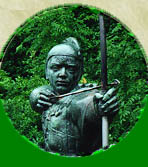
|
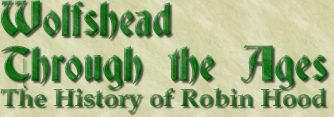
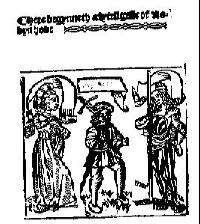 The
largest, and arguably most important, early ballad is
The
largest, and arguably most important, early ballad is 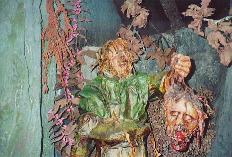 And what of Robin's accomplices? The ballads don't always specify the number of men who follow Robin. In Robin Hood and the Monk, Robin is told to take 12 of his best men with him. And according to the Gest, Robin's
"Merry Men" have seven score (140) men. That's rather larger than most real medieval outlaw bands who only had a few members. But most of Robin's band are nameless background characters, only called up when the plot requires an army -- almost like the computer generated background extras of the Lord of the Rings films. Only a few characters were given names, but what names! You'd still recognize most of
them. Little John is in all the stories. He's almost as important as Robin
himself. And Will Scarlett (or Scarlock or Scadlock or Scathelock) and
Much the Miller's Son are there too. But you won't find a minstrel named
Alan a Dale, a jolly friar named Tuck, or Maid Marian.
And what of Robin's accomplices? The ballads don't always specify the number of men who follow Robin. In Robin Hood and the Monk, Robin is told to take 12 of his best men with him. And according to the Gest, Robin's
"Merry Men" have seven score (140) men. That's rather larger than most real medieval outlaw bands who only had a few members. But most of Robin's band are nameless background characters, only called up when the plot requires an army -- almost like the computer generated background extras of the Lord of the Rings films. Only a few characters were given names, but what names! You'd still recognize most of
them. Little John is in all the stories. He's almost as important as Robin
himself. And Will Scarlett (or Scarlock or Scadlock or Scathelock) and
Much the Miller's Son are there too. But you won't find a minstrel named
Alan a Dale, a jolly friar named Tuck, or Maid Marian.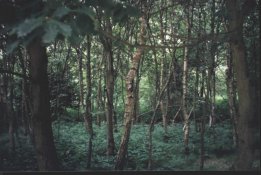 There
are many other themes that people see in the early Robin Hood ballads.
For example, many folklorists (such as John Matthews) perceive pagan themes
in the Robin Hood legend. David Wiles suggests, for example, that the fight
between Robin and Guy of Gisborne is the battle between spring/summer and
winter. Pagan themes are most prominent in the early Robin Hood plays which
are discussed in the next section.
There
are many other themes that people see in the early Robin Hood ballads.
For example, many folklorists (such as John Matthews) perceive pagan themes
in the Robin Hood legend. David Wiles suggests, for example, that the fight
between Robin and Guy of Gisborne is the battle between spring/summer and
winter. Pagan themes are most prominent in the early Robin Hood plays which
are discussed in the next section. Sherwood
Forest, right? Well, the first reference to Robin's home turf is the proverb
"Robyn hod in scherewod stod." And one of the earliest ballads, Robin
Hood and the Monk, also sings the praises of Sherwood. And an English chronicle entry from the 1460s places him in Sherwood too.
Sherwood
Forest, right? Well, the first reference to Robin's home turf is the proverb
"Robyn hod in scherewod stod." And one of the earliest ballads, Robin
Hood and the Monk, also sings the praises of Sherwood. And an English chronicle entry from the 1460s places him in Sherwood too.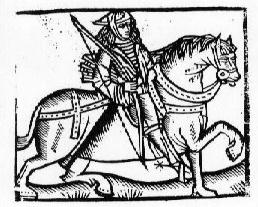 By
the mid-15th century (where we find the earliest ballads), the term "yeoman"
was used to describe the rising middle class of landowners. They held their
own land, but were not knights or noblemen. But yeoman can also refer to
royal and feudal household officers below the rank of knight. These yeomen
might keep the king's books or be in the charge of his wardrobe, or carry
his bows. The famous "beefeaters" outside the Tower of London are called
yeomen. Historically, many yeomen became
foresters, an occupation long associated with Robin Hood. A.J. Pollard draws special attention to the fact that Robin and his men are repeated called "Yeomen of the Forest", a term used for foresters. Whether proper foresters are not, yeomen
were associated with archery, like the yeoman in Chaucer's Canterbury
Tales. The woodcut on the left was used to illustrate both Chaucer's
yeoman and Robin Hood.
By
the mid-15th century (where we find the earliest ballads), the term "yeoman"
was used to describe the rising middle class of landowners. They held their
own land, but were not knights or noblemen. But yeoman can also refer to
royal and feudal household officers below the rank of knight. These yeomen
might keep the king's books or be in the charge of his wardrobe, or carry
his bows. The famous "beefeaters" outside the Tower of London are called
yeomen. Historically, many yeomen became
foresters, an occupation long associated with Robin Hood. A.J. Pollard draws special attention to the fact that Robin and his men are repeated called "Yeomen of the Forest", a term used for foresters. Whether proper foresters are not, yeomen
were associated with archery, like the yeoman in Chaucer's Canterbury
Tales. The woodcut on the left was used to illustrate both Chaucer's
yeoman and Robin Hood.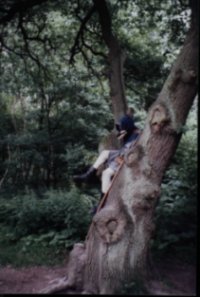 Making
Robin Hood a yeoman was accurate to the real-life crime of the middle ages.
Studying 14th century outlaws Barbara Hanawalt notes that "we have enough
evidence to know that indicted bandits were not the dregs of society, but
rather at least middling peasants or yeoman. At only 1 percent, knights
were not common in these bands and certainly no nobility was ever indicted
in jail delivery for banitry." ("Ballads and Bandits: Fourteenth-Century
Outlaws and the Robin Hood poems" found in Robin Hood -- An Anthology
of Scholarship and Criticism, p.269). She also mentions how real bandits
did Robin Hood-like feats of daring, like rescuing a prisoner from Norwich
Castle in 1318 or freeing criminals from the gallows. But unlike their
legendary counterparts, real bandits needed supplies and often stole from
the poor and helpless. Robin Hood made his men swear never to harm a woman,
yet women and children were twice as likely to be killed by bandits than
in ordinary homocides. 37 percent of victims in 13th century bandit related
homocides were women.
Making
Robin Hood a yeoman was accurate to the real-life crime of the middle ages.
Studying 14th century outlaws Barbara Hanawalt notes that "we have enough
evidence to know that indicted bandits were not the dregs of society, but
rather at least middling peasants or yeoman. At only 1 percent, knights
were not common in these bands and certainly no nobility was ever indicted
in jail delivery for banitry." ("Ballads and Bandits: Fourteenth-Century
Outlaws and the Robin Hood poems" found in Robin Hood -- An Anthology
of Scholarship and Criticism, p.269). She also mentions how real bandits
did Robin Hood-like feats of daring, like rescuing a prisoner from Norwich
Castle in 1318 or freeing criminals from the gallows. But unlike their
legendary counterparts, real bandits needed supplies and often stole from
the poor and helpless. Robin Hood made his men swear never to harm a woman,
yet women and children were twice as likely to be killed by bandits than
in ordinary homocides. 37 percent of victims in 13th century bandit related
homocides were women.